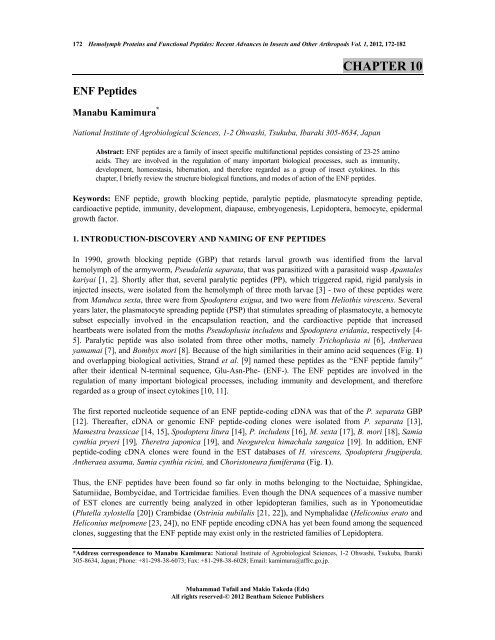chapter 1 - Bentham Science
chapter 1 - Bentham Science
chapter 1 - Bentham Science
Create successful ePaper yourself
Turn your PDF publications into a flip-book with our unique Google optimized e-Paper software.
172 Hemolymph Proteins and Functional Peptides: Recent Advances in Insects and Other Arthropods Vol. 1, 2012, 172-182<br />
ENF Peptides<br />
Manabu Kamimura *<br />
National Institute of Agrobiological <strong>Science</strong>s, 1-2 Ohwashi, Tsukuba, Ibaraki 305-8634, Japan<br />
Muhammad Tufail and Makio Takeda (Eds)<br />
All rights reserved-© 2012 <strong>Bentham</strong> <strong>Science</strong> Publishers<br />
CHAPTER 10<br />
Abstract: ENF peptides are a family of insect specific multifunctional peptides consisting of 23-25 amino<br />
acids. They are involved in the regulation of many important biological processes, such as immunity,<br />
development, homeostasis, hibernation, and therefore regarded as a group of insect cytokines. In this<br />
<strong>chapter</strong>, I briefly review the structure biological functions, and modes of action of the ENF peptides.<br />
Keywords: ENF peptide, growth blocking peptide, paralytic peptide, plasmatocyte spreading peptide,<br />
cardioactive peptide, immunity, development, diapause, embryogenesis, Lepidoptera, hemocyte, epidermal<br />
growth factor.<br />
1. INTRODUCTION-DISCOVERY AND NAMING OF ENF PEPTIDES<br />
In 1990, growth blocking peptide (GBP) that retards larval growth was identified from the larval<br />
hemolymph of the armyworm, Pseudaletia separata, that was parasitized with a parasitoid wasp Apantales<br />
kariyai [1, 2]. Shortly after that, several paralytic peptides (PP), which triggered rapid, rigid paralysis in<br />
injected insects, were isolated from the hemolymph of three moth larvae [3] - two of these peptides were<br />
from Manduca sexta, three were from Spodoptera exigua, and two were from Heliothis virescens. Several<br />
years later, the plasmatocyte spreading peptide (PSP) that stimulates spreading of plasmatocyte, a hemocyte<br />
subset especially involved in the encapsulation reaction, and the cardioactive peptide that increased<br />
heartbeats were isolated from the moths Pseudoplusia includens and Spodoptera eridania, respectively [4-<br />
5]. Paralytic peptide was also isolated from three other moths, namely Trichoplusia ni [6], Antheraea<br />
yamamai [7], and Bombyx mori [8]. Because of the high similarities in their amino acid sequences (Fig. 1)<br />
and overlapping biological activities, Strand et al. [9] named these peptides as the “ENF peptide family”<br />
after their identical N-terminal sequence, Glu-Asn-Phe- (ENF-). The ENF peptides are involved in the<br />
regulation of many important biological processes, including immunity and development, and therefore<br />
regarded as a group of insect cytokines [10, 11].<br />
The first reported nucleotide sequence of an ENF peptide-coding cDNA was that of the P. separata GBP<br />
[12]. Thereafter, cDNA or genomic ENF peptide-coding clones were isolated from P. separata [13],<br />
Mamestra brassicae [14, 15], Spodoptera litura [14], P. includens [16], M. sexta [17], B. mori [18], Samia<br />
cynthia pryeri [19], Theretra japonica [19], and Neogurelca himachala sangaica [19]. In addition, ENF<br />
peptide-coding cDNA clones were found in the EST databases of H. virescens, Spodoptera frugiperda,<br />
Antheraea assama, Samia cynthia ricini, and Choristoneura fumiferana (Fig. 1).<br />
Thus, the ENF peptides have been found so far only in moths belonging to the Noctuidae, Sphingidae,<br />
Saturniidae, Bombycidae, and Tortricidae families. Even though the DNA sequences of a massive number<br />
of EST clones are currently being analyzed in other lepidopteran families, such as in Yponomeutidae<br />
(Plutella xylostella [20]) Crambidae (Ostrinia nubilalis [21, 22]), and Nymphalidae (Heliconius erato and<br />
Heliconius melpomene [23, 24]), no ENF peptide encoding cDNA has yet been found among the sequenced<br />
clones, suggesting that the ENF peptide may exist only in the restricted families of Lepidoptera.<br />
*Address correspondence to Manabu Kamimura: National Institute of Agrobiological <strong>Science</strong>s, 1-2 Ohwashi, Tsukuba, Ibaraki<br />
305-8634, Japan; Phone: +81-298-38-6073; Fax: +81-298-38-6028; Email: kamimura@affrc.go.jp.

















